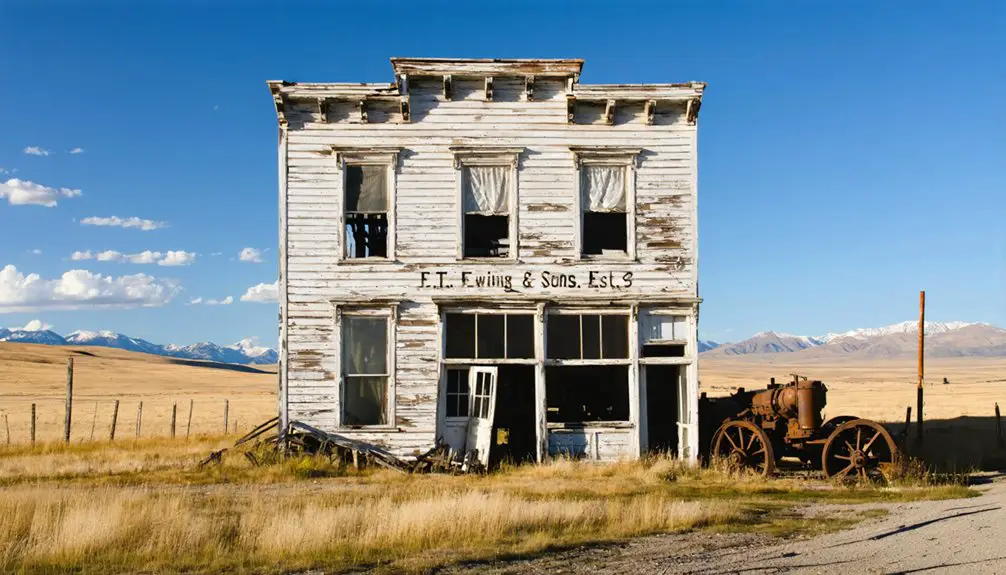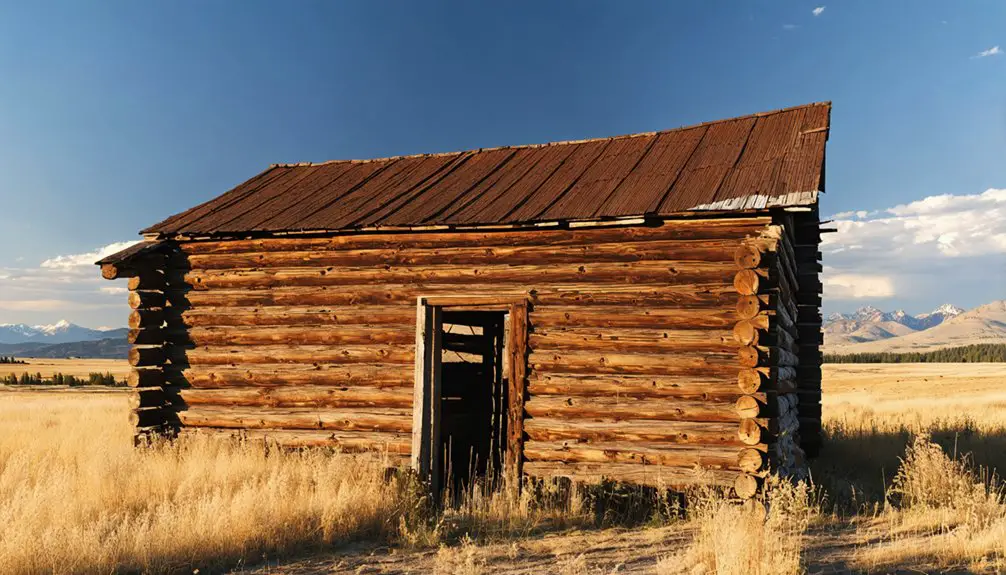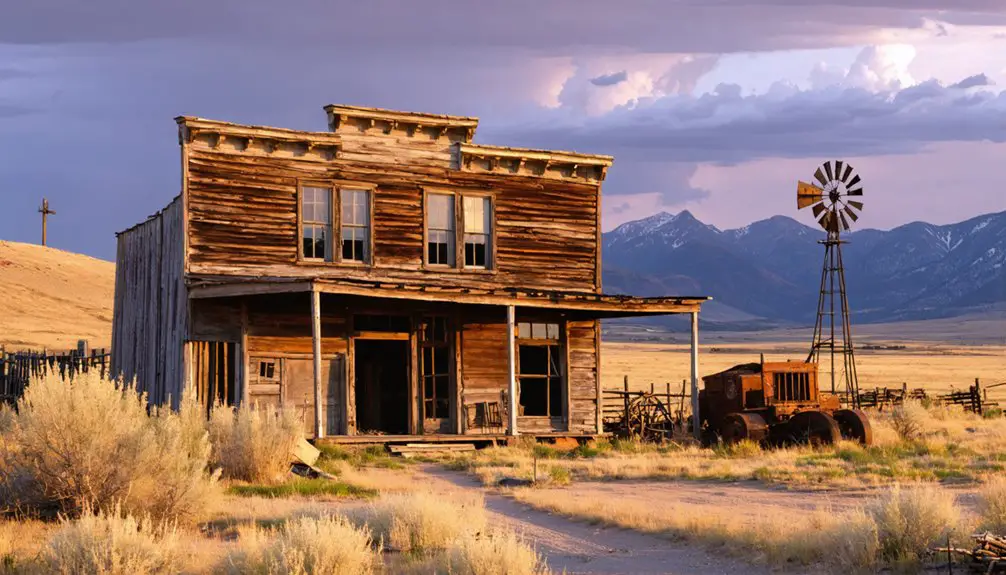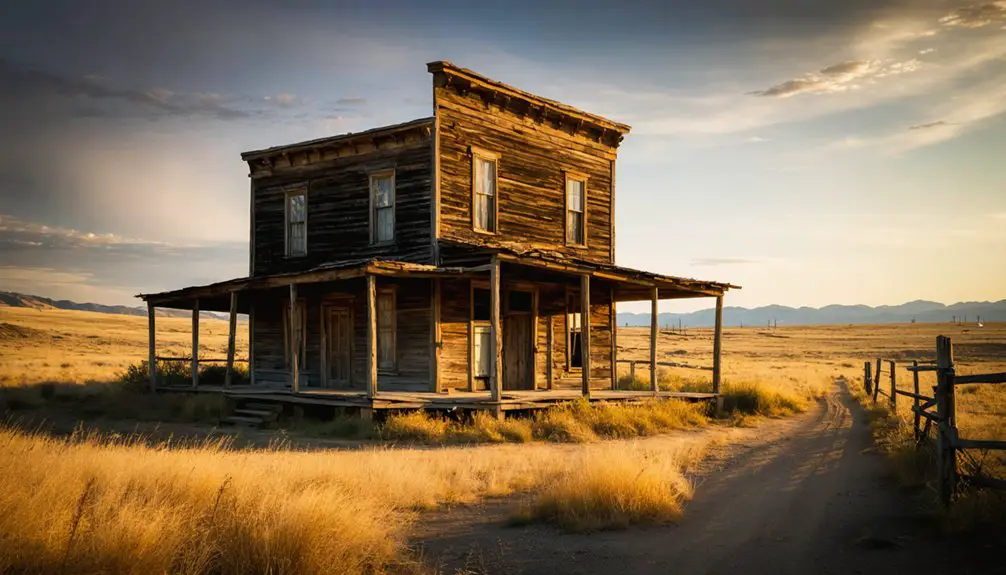You’ll find the remnants of Ewing ghost town near Montana’s Bighorn Canyon, where Erastus T. Ewing’s 1896 gold mining aspirations transformed into a successful ranching operation. While his 7,000 acres of mining claims yielded minimal returns, Ewing adapted by developing irrigation systems and establishing essential ranch infrastructure, including a post office by 1898. Today, the abandoned Ewing Ranch structures stand as silent witnesses to Montana’s evolution from mining dreams to ranching reality. The site’s rich history holds countless frontier stories waiting to be discovered.
Key Takeaways
- Ewing began as a gold mining settlement in 1896 when Erastus T. Ewing staked over 7,000 acres of claims in Montana’s Bighorn Canyon.
- Poor gold returns led Ewing to transition from mining to ranching, establishing irrigation systems and essential ranch infrastructure.
- The settlement gained prominence with a post office in 1898 and became a community hub with school facilities.
- Today, Ewing exists as a ghost town on private property, with preservation efforts needed to protect its historical structures.
- The site represents Montana’s economic evolution from mining to ranching, though it lacks state protection unlike other ghost towns.
From Gold Dreams to Ranch Reality
While Montana’s gold rush era sparked dreams of wealth throughout the territory, the story of Ewing illustrates how those dreams often yielded to more practical pursuits.
The rapid rise of mining towns like Virginia City had inspired many hopeful prospectors across Montana. When Erastus T. Ewing began his gold claims in 1896, he’d hoped to strike it rich in the Bighorn Canyon area. Instead, you’ll find that his legacy took root in ranching rather than mining.
The property eventually became part of the Bighorn Canyon National Recreation Area, preserving its historical significance for future generations. As prospecting efforts failed to produce substantial deposits, Ewing pivoted to establish a sustainable ranch operation by the late 1890s. He transformed the landscape by diverting Layout Creek’s waters for irrigation, and soon other settlers followed suit.
The establishment of a post office in 1898 marked the community’s shift from transient mining camp to permanent ranching settlement, cementing its ranch heritage.
Life Along Bighorn Canyon
The dramatic landscape of Bighorn Canyon shaped not just Ewing’s settlement but the lives of countless inhabitants over millennia.
You’ll find evidence of this rich indigenous heritage along the Bad Pass Trail, where for 12,000 years, Native peoples traversed the rugged terrain for seasonal hunting and gathering.
Today, you can witness the canyon ecology in action as bighorn sheep navigate the limestone cliffs rising up to 2,500 feet, while diverse plant communities thrive in distinct elevation zones.
The canyon’s unique character comes from its deeply entrenched meanders, carved through ancient marine fossil beds over five million years.
Whether you’re paddling the reservoir at Crooked Creek or hiking the historic paths, you’re experiencing a landscape that’s supported life from prehistoric times through the present day.
The area’s hydrology created a true highland oasis, with yearly snowfall feeding vital river systems and sustaining the surrounding ecosystem.
The canyon walls reveal 38 million years of exposed Paleozoic carbonate rock, telling the story of ancient marine environments that once covered the region.
The Legacy of Erastus T. Ewing

While you’d see Erastus T. Ewing‘s initial dreams of striking gold in Montana’s Bighorn Canyon region ultimately fail, his pivot to ranching proved far more enduring.
You’ll find his transformation from prospector to rancher created a lasting foothold in the harsh Dryhead Country through the establishment of the Ewing Ranch in 1896.
His legacy lives on through the ranch complex that became an essential community hub, complete with a post office and school, serving as a testament to frontier adaptability and perseverance. Modern researchers can explore his family connections through historical records on genealogy websites.
His son Lee W. Ewing continued his father’s vision after 1904, expanding the ranch’s water rights and building upon the foundation Erastus had established.
From Mining to Ranching
During Montana’s late 19th century gold rush, Erastus T. Ewing staked over 7,000 acres of mining claims in the Dryhead Country, hoping to strike it rich in the Bighorn Mountains.
When his mining techniques yielded only minimal gold returns, he quickly adapted his strategy to survive in this rugged frontier.
Here’s how Ewing transformed his operation:
- Converted mining claims into grazing lands for livestock
- Developed water sources, including Layout Creek for irrigation
- Established essential ranch buildings and infrastructure
- Created a self-sufficient ranching operation that sustained the local community
Ewing’s shift to ranching practices proved more lucrative than his mining ventures.
His ranch became a cornerstone of the region, hosting a post office by 1898 and serving as an economic hub for the sparsely populated Bighorn Canyon area. The historic property, established in 1896, would later become an important part of the Bighorn Canyon National Recreation Area.
Ambitious Gold Dreams Failed
Despite early promise from nearby Bald Mountain gold strikes, Erastus T. Ewing’s ambitious mining venture in Dryhead ultimately joined the ranks of failed aspirations across Montana’s mining frontier.
You’ll find his story emblematic of the era’s challenges – while he secured seven claims totaling 1,160 acres in 1896, the anticipated mother lode never materialized.
Mining challenges proved insurmountable in this arid landscape. Unlike Montana’s rich southwestern gold fields, Dryhead’s remoteness and harsh conditions thwarted Ewing’s dreams of striking it rich. Without the placer gold deposits that made regions like Alder Gulch prosperous in the 1850s, success remained elusive. The area would later see success with American Gem Mining Syndicate discovering valuable sapphire deposits in 1892.
Though he appropriated water rights from Layout Creek in 1897, the region’s limited gold yields couldn’t sustain a mining economy.
Built Lasting Ranch Community
The failure of mining prospects sparked Erastus T. Ewing to establish a thriving ranch community in Montana’s Dryhead Country in 1896.
You’ll find his legacy reflected in the ranch culture that flourished along Layout Creek, where he transformed barren land into productive ranchland through strategic water rights and irrigation.
- Built the first permanent settlement north of Crooked Creek
- Established an essential post office by 1898, serving the growing population
- Created sustainable farming operations that supported multiple families
- Developed lasting infrastructure including houses, stables, and a schoolhouse
The community’s resilience shines through successive owners, from Ewing’s son Lee to the Snell family, who maintained the ranch until 1968.
Today, you can explore these preserved buildings within the Bighorn Canyon National Recreation Area, proof of the frontier spirit that shaped Montana’s ranching heritage.
Daily Life in a Frontier Settlement

Life in Montana’s frontier settlements demanded relentless effort from every family member, as daily survival hinged on a complex web of essential tasks. You’d find yourself working from dawn to dusk, tending livestock, preserving food, and maintaining shelter against harsh elements.
Your family’s settler struggles included chopping wood for the single stove that provided both heat and cooking, while children gathered buffalo chips for supplemental fuel.
Frontier survival meant adapting quickly to environmental challenges. You’d preserve meat and vegetables for winter, spin wool into clothing, and rely on basic medical knowledge to treat injuries and illness. Sickness and malnutrition posed constant threats to settler families trying to establish themselves in the harsh territory.
Your home might be a simple sod structure or kit house insulated with newspaper, while daily meals consisted of cornmeal mush, home-baked bread, and whatever game you could hunt.
Building a Community in Montana Territory
You’ll find that early settlers in Montana Territory faced formidable challenges of isolation, harsh weather, and limited resources while establishing communities like Ewing.
The discovery of precious metals brought waves of hopeful miners who constructed makeshift towns practically overnight, complete with general stores, saloons, and rudimentary housing.
As mining prospects waned, resilient ranching families established more permanent roots, converting mining claims into grazing lands and building sustainable agricultural communities.
Early Settlement Challenges
When settlers first ventured into Montana Territory during the mid-1800s, they encountered a formidable array of geographic and environmental challenges that tested their resilience.
You’d find your settlement struggles intensified by Montana’s unforgiving landscape and harsh climate, forcing adaptations to survive.
Here’s what you’d face as an early settler:
- Water scarcity required innovative solutions like diverting Layout Creek for irrigation.
- Poor soil conditions severely limited crop yields and farming options.
- Brutal winters and unpredictable rainfall threatened livestock survival.
- Remote locations cut you off from essential supplies and communication.
These environmental hurdles meant you couldn’t rely on traditional farming methods.
Instead, you’d need to combine multiple survival strategies – from subsistence ranching to trading – while learning from Native American knowledge of the land to overcome the territory’s demanding conditions.
Growth Through Mining Dreams
Dreams of mineral wealth transformed Montana Territory’s landscape in the late 1800s, as prospectors and settlers flocked to potential mining sites across the region.
You’d find the mining impact extending far beyond the initial gold and silver discoveries, spurring rapid development of essential infrastructure and services. As claims expanded, you could witness railroad companies racing to connect mining towns, while technologies like dredging opened new possibilities for resource extraction.
Community resilience emerged through this period of growth, as mining camps evolved into stable settlements.
You’d see post offices, schools, and stores springing up alongside diverse immigrant populations. When mining prospects dimmed, as they did in places like Ewing, you’d find settlers adapting – shifting to ranching and agriculture, demonstrating the frontier spirit‘s remarkable ability to survive and thrive.
Ranch Life Takes Root
The establishment of Saint Mary’s Mission in 1841 marked Montana Territory’s shift from temporary mining camps to permanent agricultural settlements.
You’ll find that early settlers brought innovative ranch practices while adapting to Montana’s unique climate and terrain. Through partnerships with Native Americans, particularly the Salish and Kootenai tribes, ranchers developed effective livestock management techniques suited to the region’s challenges.
Key developments that shaped ranch life in Montana Territory:
- Construction of irrigation systems and strategic fencing for ideal grazing control
- Diversification of livestock including cattle, horses, and sheep for economic stability
- Integration of sawmills and trading posts to support ranch operations
- Development of community infrastructure including schools and churches near water sources
These ranch innovations transformed the territory, creating resilient communities that could weather environmental and economic challenges while maintaining independence.
Mining Claims and Economic Evolution
Despite their early promise, mining claims in Ewing delivered minimal returns after Erastus Ewing and his partners staked nine prospects between August 1896 and February 1897.
You’ll find that their mining claims yielded only minor gold discoveries, leading most prospectors to quickly abandon their pursuits in the area. The lackluster results prompted a significant economic change, with Ewing himself shifting to ranching by 1898.
This economic evolution mirrors a common pattern you’ll see throughout Montana’s ghost towns, where failing mining ventures gave way to more sustainable industries.
The establishment of Ewing’s ranch along Layout Creek, complete with irrigation systems and holding ponds, proved more viable than the mining claims. This change supported multiple families and even warranted the opening of a post office in 1898, demonstrating the area’s successful adaptation to ranching.
Preservation and Historical Significance

While Ewing ranks among Montana’s most historically significant ghost towns, its preservation faces unique challenges due to private ownership status. Unlike Bannack State Park, which benefits from state protection, Ewing’s historical structures remain vulnerable to natural decay despite legal safeguards against vandalism.
Private ownership leaves Ewing’s historic structures at risk, while state-protected ghost towns like Bannack enjoy dedicated preservation resources.
You’ll find that resident families have acquired much of the site with preservation intent, but without organized conservation efforts, several historic buildings have been lost in recent decades.
- The site needs “Arrested Decay” preservation methods to protect remaining structures
- Interpretive signage would enhance educational value for visitors
- Community support through heritage associations could strengthen preservation efforts
- Private-public partnerships could secure long-term maintenance funding
Like other Montana ghost towns, Ewing serves as a crucial connection to the state’s mining heritage and settlement history.
Exploring the Ghost Ranch Today
Located inside Bighorn Canyon National Recreation Area, Ewing Ghost Ranch offers visitors a glimpse into Montana’s rugged ranching past through its collection of preserved 19th-century structures.
You’ll find the site north of Lovell, Wyoming, accessible via County Road 37, where original buildings, including the main house, stables, and school, await your exploration.
While you won’t find modern amenities here, you’ll discover authentic ranching artifacts throughout the property and can experience the site’s raw, untamed atmosphere.
Pack essential supplies, as facilities are limited. Your private vehicle should be suitable for unpaved roads.
The remote location enhances opportunities for ghostly encounters amid the historic buildings, especially during quiet morning or evening hours.
Consider combining your visit with hiking and wildlife viewing in the surrounding recreation area.
Montana’s Rural Heritage

Throughout Montana’s rich past, ranching and agriculture have shaped the state’s enduring rural identity, with nearly two-thirds of counties maintaining significant heritage properties today.
From the open-range cattle drives of the 1860s to the shift to fenced ranches after the devastating winter of 1886-1887, you’ll find a legacy that’s deeply woven into the state’s cultural fabric.
Today’s cultural preservation efforts showcase Montana’s commitment to protecting its rural heritage:
- The RMRH grant program funds restoration projects up to $100,000 for historic rural properties
- 146 state-owned properties are listed on the National Register of Historic Places
- The Montana Heritage Commission preserves gold rush-era structures in Virginia City and Nevada City
- Seven state parks have achieved National Historic Landmark status, boosting heritage tourism
Frequently Asked Questions
What Happened to Erastus T. Ewing After He Left the Ranch?
You won’t find records of Erastus’s travels after the ranch because he died in 1904, but his legacy lived on through his son Lee, who expanded the ranch’s irrigation operations.
Were There Any Notable Conflicts With Native Americans at Ewing Ranch?
You won’t find any documented conflicts with Native Americans at Ewing Ranch in historical records. While the broader Montana territory saw native relations tensions, no specific conflict history exists for this location.
What Was the Highest Population Ewing Ever Reached?
While 90% of Montana ghost towns saw over 1,000 residents, Ewing’s economy never supported that scale. You’ll find estimates suggesting the population peaked at 100-200 people during its ranching heyday.
Did Any Famous Outlaws or Historical Figures Visit Ewing?
You won’t find records of famous visitors or historical figures in Ewing’s past. The town’s limited historical significance centered solely on founder Erastus T. Ewing and his family’s ranching endeavors.
How Did Residents Get Medical Care in This Remote Location?
With 80% of Montana mining towns lacking resident doctors, you’d rely on self-care, folk remedies, and neighbors until medical transport could reach you or you’d travel to larger towns for rural healthcare.
References
- https://www.legendsofamerica.com/ewing-montana/
- https://www.youtube.com/watch?v=K5sIVHBhTl8
- https://glaciermt.com/ghost-towns
- https://www.montanaliving.com/blogs/destinations/explore-montana-ghost-towns
- https://www.ghosttowns.com/states/mt/ewing.html
- https://archiveswest.orbiscascade.org/ark:/80444/xv28731
- https://mhs.mt.gov/education/textbook/chapter6/Chapter6.pdf
- https://westernmininghistory.com/10183/principal-gold-districts-of-montana/
- https://westernmininghistory.com/library/136/page1/
- https://en.wikipedia.org/wiki/Bighorn_Mountains



